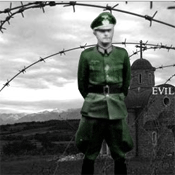 |
|
 |
 |
 |
 |
 |
  |
webwork 4
INSTANT MEMORY,
by Patricia RYDZOK and Pedro VITORINO (France), 2004
 YOU'LL ALWAYS THROW AGAIN
YOU'LL ALWAYS THROW AGAIN
Every time you throw the three dice you get a new combination. If it's worse, you hope for better, and throw again. If it's better, you want more. . . and throw again. That is what Instant Memory is about.
Built of a series of image-text-sound variations on three themes - war, cloning, and pollution -, the work knits together a mix of random and ordered elements. After three scenes, an after-trace of the navigation appears as a three-verse haiku, an instant snapshot of your path.
Repeat the experience several times, and you'll realize that the three images are randomly created from the superimposition of several layers: for instance, a field strewn with sheep under a blue sky in scene A becomes a field of sheep in scene A', this time with a dark, cloud-laden sky and a robot strutting over the mountain pasture.
On this changing background, a choice of words is given - engaging, laden with consequence, and clickable: biologique ou usine ("biological or factory"), clonage et embryon ("cloning and embryo"), trash ou non, etc. You'll realize that one proceeds through the work by clicking on the words, while the images keep their interrogative power. A dichotomy is thus maintained between words, which signify and have their counterpart in a dictionary, and images, so much more untamed, subject to interpretation, even incomprehensible.
But do the proposed words, which are anything but banal, really signify what they refer to? While you may find a relationship between what is shown in the images and what the words say, the randomness of the installation introduces an uncertainty that disturbs immediate comprehension. The haiku obtained as a trace of the navigation will not always help you make sense of the situation.
So the action of clicking on a word to guide your immediate choice will seem a slippery slope. On what basis do you choose this word over that one? What do you conclude on the relationship between image and text? And what of the music - often soft, Satie-esque tunes, on a background of pollution, war, and death -, what does it say?
The fascinating aspect of this work lies in this interrogation of the traditional functions given to reading (which reassures - reading reassures me, even in a foreign country, the fact of reading advertisements, promotional banners, traffic signs, information of all kinds, when I don't understand the language, affords a kind of relief - I'm reading, words are written, words that say something, that have referents, dictionary definitions) and to visuals, which can certainly inform, but which also keep their ability to disorient. Randomness plays its part, it disrupts, it baffles, threatens sometimes to lose the thread. The false appearance induced by the double and triple rhyming schemes - two words given in each scene, but there are three scenes, three themes, and three verses in the final haiku - becomes intriguing. With two, you choose, with three, you're lost.
Your ultimate implication in the work, in the end, is the haiku, which can either be rich in meaning, or totally inept and disappointing. It is the ultimate limit - and strength - of randomness: always, hope endures that the next throw will be the good one, that meaning will finally emerge, the poem spring into being.
Your instant memory, a poetic flash.
Xavier Malbreil
(Translated from French by Ron Ross)

 top top
 back back
|
|
 |
 |
 |
|
